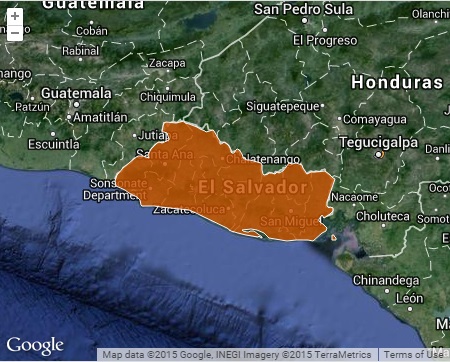You are here
EPDC Spotlight on El Salvador
.jpg)
This post continues our Country Spotlight series, where we highlight a different country and the resources we offer, such as data, country profiles, research or other tools that users have available to them through the website. In this post, we highlight the data resources we have for El Salvador.
El Salvador is a lower-middle income country located in the Pacific Coast of Central America, bordered to the north/northeast by Honduras and the north/northwest by Guatemala. El Salvador is the smallest and most densely populated Central American country. As of 2013, the poverty rate was 28.9%, having decreased from 34.5% in 2012. The country’s civil war, which lasted from the late 1970s through the 1980s, ended in 1992 with the Chapultepec Peace Accords. Following the peace accords, El Salvador’s net enrollment rates increased rapidly in the late 1990s and early 2000s.
Figure 1. Map of El Salvador

The School System in El Salvador
El Salvador’s academic school year begins in January and ends in November, and the official primary school entrance age is 7. As of 2014, a total of 1,470,000 pupils were enrolled in primary and secondary education. Since 2010, UIS has classified the school structure as 6-3-3 (six years of primary, followed by three years of lower secondary and three years of upper secondary). However, nationally, the system is classified as a 9-2 system, with three 3-year cycles of basic school, followed by two years of secondary school, which is referred to as bachillerato.
Country Context: Gang Violence and Migration of Children
A previous EPDC blog post discussed the critical importance of gang violence and the related migration of tens of thousands of children to the United States from El Salvador as well as from its neighbor countries, Honduras and Guatemala. In fact, in 2011, El Salvadorans accounted for the third-largest population of Hispanic origin living in the U.S. In 2014, more than 22% of El Salvadoran unaccompanied minors apprehended in the U.S. were under the age of 12, with primary reasons cited by families for sending their children to the U.S. being gang violence and poverty.
Historically, El Salvador has had one of the highest homicide rates in Central America. Approximately 6,300 children and adolescents were victims of homicide from 2005 to 2013, and a total of 3,912 homicides were registered in 2014, up 57% from the previous year, as a truce between the country’s most powerful gangs fell apart.
Participation in Primary and Secondary Education
Both gang violence and the exodus of a large number of children from the country could potentially have an impact on school enrollment and dropout rates in El Salvador, which has significantly expanded its access to education in the past decades. We might also expect lower rates of participation in schooling, progression through schooling, and educational attainment among males than among females, if males are targeted more heavily for gang recruitment. On the other hand, as gangs have perpetrated sexual violence against girls and women, parents may be deterred from sending their daughters to school, leading possibly to lower educational participation and attainment among females.
Looking at Figure 2, which displays net enrollment rates for the seven Central American countries for 2010-2011, it is clear that in 2012, primary enrollment was comparable across countries. El Salvador has the third-highest primary net enrollment rates, at 93.4%, following Honduras and Belize. Secondary net enrollment rates, however, are less similar across countries. Enrollment rates are much lower for secondary across all countries, but especially for the 4 lower-middle income countries of El Salvador, Guatemala, Honduras, and Nicaragua.
Higher Educational Attainment Among Females
Given the country’s prevalence of gang violence, as discussed above, we might also expect to find higher educational attainment among females than males, if gangs recruit more heavily among male youth. In fact, from looking at Figure 4, which displays data on mean years of schooling by gender and region, it is clear that female educational attainment is overall higher in the 15-24 year old age group. Females have higher mean years of schooling across the regions of San Salvador, San Vicente, San Miguel, Usulután, Cabañas, La Unión, Morazán, and Chalatenango. Female mean years are lower than male mean years only in La Paz, Sonsonate, and Ahuachapán, and they are the same in Cuscatlán and La Libertad. However, it is important to note that this trend of higher mean years of schooling among females is present for many subregions across other Central American countries for which data is available—Belize, Nicaragua, Honduras, and Panama—displayed here as well.
Several additional trends are worth highlighting (see Figure 5). In El Salvador, the grade 1 repetition rate in 2012 is 11.6% (for both males and females), 5.6% points higher than the average repetition rate across primary grades of 6.0%. The repetition rate is also notably high in secondary grade 1 at 8.1%. These relatively high repetition rates in grades 1 of primary and secondary school also correspond with relatively high dropout rates, especially in secondary grade 1, where they are at 8.45%. Dropout rates are also high in secondary grade 2, at 7.23%.
Unique EPDC Data Collections to Explore
Among other data sources, unique EPDC data collections for El Salvador include administrative data from the Ministry of Education (2007), household survey data from SITEAL (1997-2009), and indicators derived from UIS data. Visit EPDC’s National Education Profile for El Salvador and El Salvador's country landing page to explore additional education data and to compare El Salvador’s percentile rank relative to other low- and middle-income countries.

Add new comment